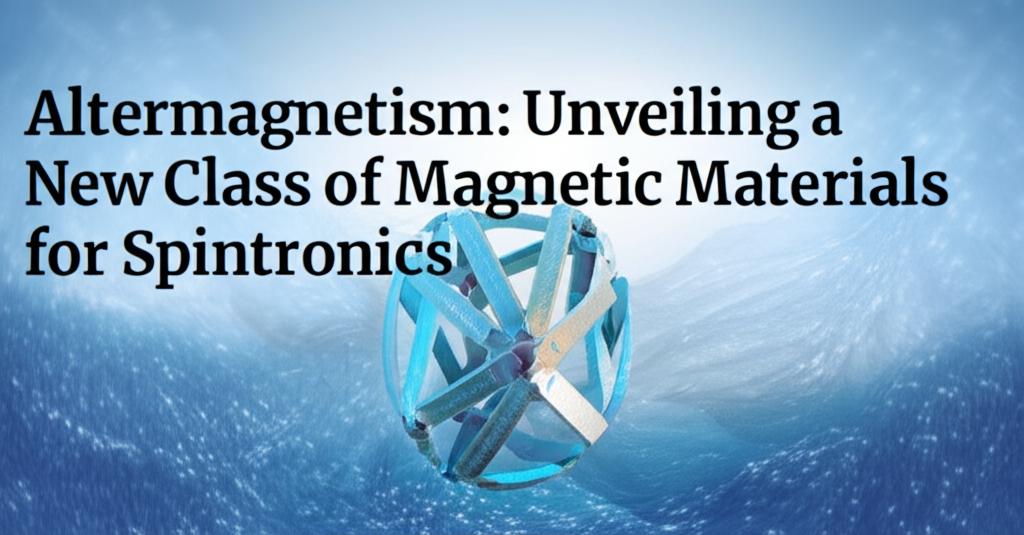The field of magnetism has traditionally been dominated by ferromagnets and antiferromagnets. However, a new class of magnetic materials, known as altermagnets, is rapidly emerging and capturing the attention of the spintronics community. Altermagnets uniquely blend characteristics of both traditional magnetic orders, offering exciting new possibilities for next-generation electronic devices.
What Makes Altermagnets Different?Altermagnets are characterized by an antiparallel arrangement of magnetic moments (spins) similar to antiferromagnets, meaning they typically have no net magnetization. This lack of net magnetization makes them robust against external magnetic fields, a desirable trait for data storage. However, unlike conventional antiferromagnets, altermagnets exhibit a peculiar electronic band structure with spin-polarized currents, a feature usually associated with ferromagnets. This unique combination arises from specific crystal symmetries that connect the opposing magnetic sublattices through rotation, rather than simple translation or inversion. This leads to a phenomenon called non-relativistic spin splitting, where different spin states have different energies even without the presence of strong spin-orbit coupling. This results in broken time-reversal symmetry, leading to novel transport properties.
Key Properties and Potential Applications in Spintronics:The distinct properties of altermagnets open up a range of potential applications in spintronics, a field focused on utilizing electron spin, in addition to its charge, to carry and process information.
- Spin-Polarized Currents without Net Magnetization: One of the most significant advantages of altermagnets is their ability to generate and carry spin-polarized currents despite having zero net magnetization. This is crucial for spintronic devices, which rely on the manipulation of electron spin.
- High-Speed Dynamics: Similar to antiferromagnets, altermagnets are predicted to support ultrafast dynamics, potentially operating in the terahertz (THz) frequency range. This could lead to significantly faster data processing and memory devices.
- Enhanced Stability: The absence of stray magnetic fields, due to zero net magnetization, means that data stored in altermagnetic materials would be more stable and less susceptible to interference from external magnetic fields. This could lead to higher-density storage solutions.
- Novel Transport Phenomena: Altermagnets can exhibit unusual transport effects like the anomalous Hall effect and the crystal Nernst effect. These phenomena, not fully explained by traditional magnetic theories, can be harnessed for new functionalities in spintronic devices.
- Spin-Splitter Torques and Spin Currents: The unique spin structure of altermagnets allows for the generation of spin currents and spin-splitter torques, which are essential for manipulating magnetic states in spintronic devices.
- Tunability: Recent theoretical work has proposed methods to electrically tune the properties of altermagnets, for instance, by switching them between an altermagnetic and an antiferromagnetic state using an electric field. This "spin faucet" concept could allow for precise control over spin-polarized currents, akin to writing data to a solid-state drive. This opens avenues for high-speed, low-power spintronic devices.
The field of altermagnetism is experiencing rapid growth, with significant theoretical and experimental advancements:
- Experimental Confirmation: Researchers have experimentally observed altermagnetic band splitting and spin polarization in materials like manganese telluride (α-MnTe) and chromium antimony (CrSb), even at room temperature. Advanced techniques like angle-resolved photoemission spectroscopy (ARPES) and X-ray magnetic circular dichroism (XMCD) are proving crucial for identifying and characterizing these materials.
- Room-Temperature 2D Altermagnets: A groundbreaking development is the experimental observation of a two-dimensional (2D) layered altermagnet that remains stable at room temperature. This discovery, featuring a phenomenon called C-paired spin-valley locking, offers efficient spin control without relying on spin-orbit coupling and opens possibilities for integrating altermagnets with other 2D materials for novel device architectures.
- Expanding Material Landscape: Altermagnetism is not confined to a niche set of materials. It has been predicted and observed in metals, semiconductors, insulators, and even superconductors. Ongoing research aims to identify and synthesize new altermagnetic materials with tailored properties. Examples include Rb₁–δV₂Te₂O and certain rutile-structured compounds.
- Synthetic Altermagnets: Researchers are also exploring "synthetic altermagnets," which involve layering different magnetic materials to engineer altermagnetic properties. This approach could provide more flexibility in designing materials with specific functionalities.
- Exploring New Phenomena: Beyond basic spintronic applications, researchers are investigating the interplay of altermagnetism with other physical phenomena like superconductivity, topology, and multiferroicity. This could lead to the discovery of entirely new functionalities.
The discovery of altermagnetism marks a significant expansion of our understanding of magnetism and provides a fertile ground for innovation in spintronics. As research progresses, altermagnets hold the promise of revolutionizing information technology by enabling faster, smaller, and more energy-efficient devices for memory, computing, and beyond. The ability to control and manipulate spin in these unique materials is paving the way for the next generation of advanced electronics.

